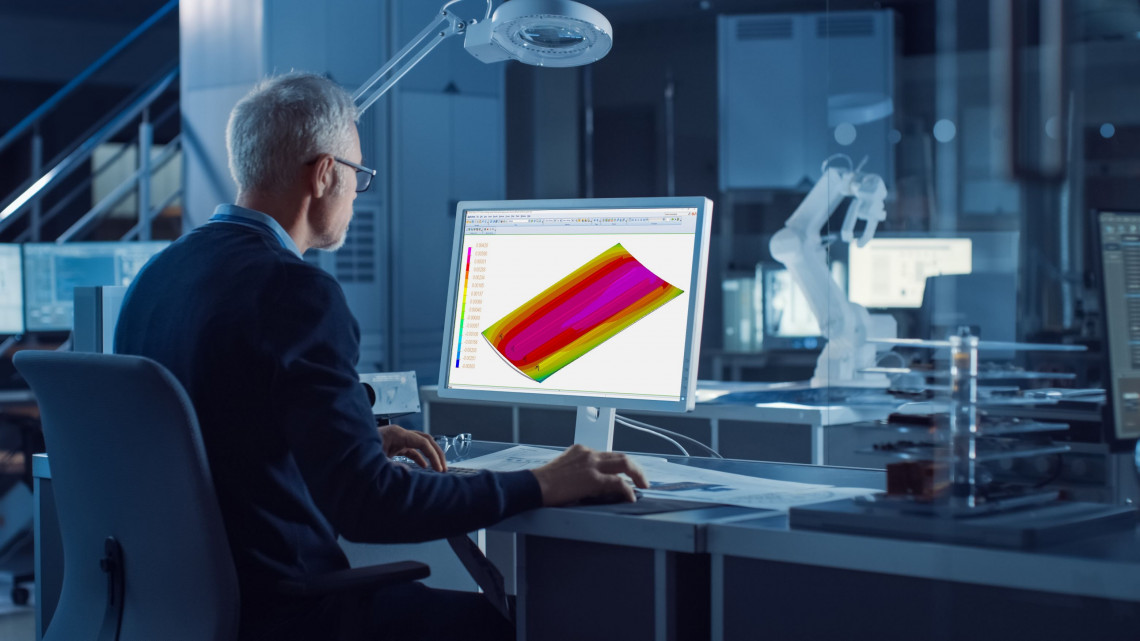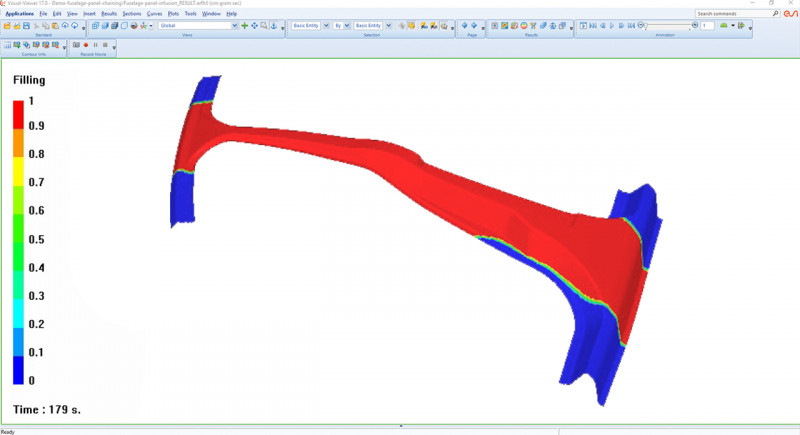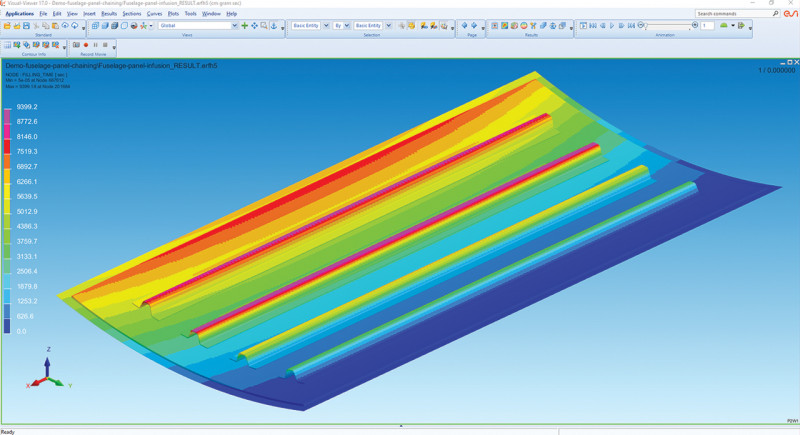Composite Simulation in the Aerospace and Automotive Industries
How Simulation can Solve Key Challenges in Composites Engineering

Composite materials have revolutionized the manufacturing processes in various industries, particularly in the aerospace and automotive sectors. Known for their exceptional strength-to-weight ratio, flexibility, and durability, these materials are crafted using various techniques involving continuous fibers, short fibers, unidirectional (UD) tapes, mats, and woven fabrics. Composite simulation has become an essential tool in predicting and optimizing the behavior of these materials throughout their lifecycle, from pre-forming and draping to resin transfer molding (RTM), curing, and performance under different conditions such as crash loading.
Here, Product Marketing Manager Mark Vrolijk talks to Tomas Nosek, composites expert and Product Manager for ESI’s PAM-COMPOSITES solution to discuss the key advantages of using composite simulation and explore what insights it can provide.
What Does Composite Simulation Refer To?

[TN] Composite simulation refers to the virtual modeling and analysis of composite material manufacturing processes and their subsequent performance. The primary goal is to anticipate and enhance the behavior of composite parts through each stage of their lifecycle. This includes the initial pre-forming and draping of fibers, the resin transfer molding process, the curing phase, and finally, their performance under various conditions.
Using composite simulation allows engineers to create detailed virtual models that simulate the entire manufacturing process, including resin injection, curing in autoclaves or ovens, and post-curing cooling phases. By inputting material properties, process parameters, and environmental conditions, simulations accurately predict how the composite material will behave during each stage of production.
What are the Key Factors and Processes in Composite Manufacturing?
Composite Materials
[TN] Prepreg and dry fibers represent two primary forms of composite materials used in manufacturing. Prepregs consist of reinforcing fibers, such as carbon or glass, that are already impregnated with a resin system. These materials undergo partial curing and are stored in controlled conditions until needed. Prepregs offer advantages such as precise resin content, uniform distribution, and ease of handling during layup, making them ideal for applications where consistent performance and reliability are essential, such as aerospace and high-performance sports equipment. In contrast, dry fibers are raw fibers without resin impregnation. They require resin application after the layup process, whether through injection, infusion, wet layup, or other methods. This approach allows for flexibility in resin selection and customization but necessitates careful handling to achieve consistent resin distribution and fiber bonding, influencing overall material properties and production efficiency. Each type offers distinct benefits tailored to specific application requirements, balancing controlled processing and customization potential accordingly.
Pre-Forming and Draping
[TN] In this initial stage, continuous fibers, UD tapes, mats, or woven or braided fabrics are arranged into the desired shape. This process is crucial because the orientation and distribution of the fibers directly impact the mechanical properties of the final composite part. Simulation plays a vital role in this stage by providing insights into fiber content and orientation, ensuring that the fibers are distributed and oriented optimally to achieve the desired strength and stiffness. It also analyzes shear angles and potential voids, identifying areas where fibers may shear or where voids may form, which can compromise the integrity of the composite. Additionally, it predicts material behavior during draping to avoid wrinkles, overlaps, and gaps. Effective simulation at this stage ensures that the pre-forming and draping processes are optimized, setting a solid foundation for subsequent stages of manufacturing.
Resin Transfer Molding (RTM) & Vacuum Assisted RTM (VARTM)
[TN] RTM involves injecting resin into a mold containing the fiber preform. This process is critical for creating high-quality composite parts, and simulation aids in assessing the filling quality to ensure complete impregnation of the fiber preform without air pockets or dry spots. It predicts weld lines, identifying areas where different resin flows might meet and form weld lines, which could be potential weak points. Moreover, it allows to control resin flow by adjusting parameters such as injection pressure, temperature, and resin viscosity to ensure uniform resin distribution and minimize defects. By using simulation to optimize RTM, manufacturers can produce parts with consistent quality and structural integrity, essential for demanding applications in aerospace and automotive industries.
VARTM is similar to RTM but uses vacuum to drive resin flow. This technique is particularly useful for large and complex parts. Simulation helps to ensure the vacuum is sufficient to draw the resin through the fiber preform uniformly, minimizing voids by predicting areas where voids might form and adjusting the process parameters to minimize these defects. Additionally, it enhances resin infiltration by simulating the vacuum-assisted resin flow to ensure thorough impregnation of the fibers, resulting in high-quality, void-free composites. Effective simulation of VARTM leads to improved part quality, reduced material waste, and higher production efficiency.
Curing
[TN] After the resin is injected, the composite undergoes curing, where heat and pressure solidify the resin. Simulation is crucial in this stage to predict the degree of cure, ensuring that the resin is sufficiently cured with the applied thermal cycle, which directly impacts the mechanical properties of the composite.
It manages distortion by predicting and compensating for distortions that occur due to uneven shrinkage or thermal expansion during curing, involving adjustments to the mold design to counteract these effects. Moreover, it supports optimization of the curing cycle by determining the optimal temperature and pressure profiles to achieve uniform curing, reduce residual stresses, and enhance the mechanical performance of the composite. By accurately simulating the curing process, manufacturers can ensure that the final composite parts meet stringent quality and performance standards.
Performance Simulation
[TN] Once the composite part is manufactured, its performance under various conditions is simulated to ensure it meets the required specifications. This includes simulating crash loading to understand how the composite part will behave under impact or crash conditions, which is critical for safety in automotive and aerospace applications. Additionally, it predicts mechanical strength and durability by simulating long-term performance under different loading conditions, including tension, compression, and shear. Moreover, it links manufacturing parameters to performance by understanding how variations in the manufacturing process impact the final performance of the composite, allowing for continuous optimization and improvement. Performance simulation helps manufacturers design composites that not only meet but exceed the performance expectations for their intended applications.
What are the Key Challenges in Composites Engineering?
[TN] Of course avoiding manufacturing issues which could negatively influence the final part quality and performance are key aspects to consider. In addition, distortion during and after the curing process is a significant challenge in composite manufacturing. This phenomenon occurs due to uneven shrinkage or thermal expansion, which can compromise the structural integrity and dimensional accuracy of the composite part. Uneven resin distribution or inadequate fiber orientation during the manufacturing process can worsen these issues, leading to distortions that may affect the final product's performance and aesthetics.
For instance, consider a scenario where a composite component undergoes curing in an autoclave. During simulation, engineers can visualize and analyze how heat and pressure affect the material. They predict areas prone to distortion due to uneven resin flow or fiber compaction. Based on these insights, adjustments are made to the mold design, such as adding additional support structures or modifying the layup sequence of composite layers.
To give an example, a leading aerospace manufacturer used simulation to optimize the curing process for a critical aircraft component. The initial physical prototypes exhibited significant distortion post-curing, impacting dimensional accuracy and structural performance. By leveraging simulation, engineers identified areas where resin flow was uneven and adjusted the autoclave cycle parameters accordingly. This proactive approach not only minimized distortion but also ensured that the final part maintained its intended shape and structural properties.
Similarly, in automotive applications, manufacturers use composite simulation to predict and mitigate distortions in body panels and structural components. By simulating the curing process, they optimize material layup and curing conditions to achieve uniform resin distribution and minimize residual stresses. This results in lighter, stronger, and more dimensionally stable components that meet severe performance and safety requirements.

Could You Give Some Examples of Use Case Scenarios Relevant for Aerospace and Automotive Industries?
[TN] Composite simulation plays a crucial role in manufacturing of structural components in the aerospace industry, such as wings, fuselage, and tail sections. These components benefit immensely from lightweight and strong composite materials. Simulation optimizes fiber layup to achieve maximum strength with minimal weight, while also enhancing crashworthiness through simulated crash scenarios to improve safety and performance.
An illustrative example of composite simulation's impact in aerospace involves a leading manufacturer. Initially, traditional methods in designing a new aircraft model revealed significant issues with weight distribution and structural integrity in early prototypes. Integrating composite simulation into the design process enabled engineers to refine the layup of composite materials in wings and fuselage. Predictive simulations assessed different configurations of continuous fibers, UD tapes, and woven fabrics under various loads, simulating draping and curing processes to identify and rectify potential weaknesses and distortions prior to physical testing. These optimizations led to substantial weight reductions, improving fuel efficiency and payload capacity. Moreover, enhanced structural durability and crashworthiness ensured compliance with stringent safety standards, while reducing development costs and accelerating time-to-market for the new aircraft model.
Similarly, in automotive manufacturing, composite simulation is indispensable for producing lightweight yet durable body panels and frames. For example, a collaboration between ESI Group and a renowned automotive OEM utilized composite simulation tools to optimize the design and manufacturing of automotive body panels. Predictive simulations enabled engineers to assess how different composite materials and configurations would perform under diverse conditions, including crash scenarios. By refining fiber layup and resin flow, the simulations enhanced strength and crash resistance, while addressing issues like fiber orientation, void formation, and curing process distortions. This collaboration enabled the OEM to deliver lighter, stronger, and safer vehicle components, reducing reliance on physical prototypes to expedite development and lower costs. Precise simulation in design and manufacturing stages resulted in overall performance improvements and heightened vehicle safety standards.
Furthermore, composite simulation aids in predicting the behavior of thermoplastic materials during blow forming processes for manufacturing automotive components such as air ducts and fluid containers. Simulations optimize inflation processes to achieve uniform wall thickness distribution, predict material stretch, and mitigate defects like thinning or wrinkling, ensuring products meet the design specifications and minimizing material waste and production costs.
Additionally, in optimizing the trimming process of automotive carpets and interior components, simulation helps in assessing potential for fiber pullout or delamination during cutting operations. By optimizing cutting patterns, manufacturers minimize material waste while enhancing production efficiency, thereby improving the quality and consistency of automotive interiors.
These examples reveal how composite simulation drives innovation, improves quality, and reduces time and costs across aerospace and automotive sectors, making it an indispensable tool for advancing manufacturing capabilities and product performance.
How Does ESI’s Composites Simulation Solution Contribute to These Type of Applications?

[TN] Our comprehensive composites solution, ESI PAM-COMPOSITES comprises of specialized modules tailored for each stage of engineering continuous fiber composite products. These modules include capabilities for pre-forming and draping of dry fabrics and pre-preg materials, as well as analysis tools for resin transfer molding (RTM) and similar infusion processes to optimize resin flow. We provide predictive capabilities for curing processes in tools or autoclaves, including distortion prediction post-curing. Integration with our Virtual Performance Solution (VPS) ensures accurate prediction of part behavior under specific loading conditions. Central to our solution is the seamless transfer of material properties across stages, enhancing predictive confidence in filling, curing, distortion control, and overall performance.
In addition to these capabilities, we offer specific solutions tailored for the automotive industry. This includes precise modeling of blow-forming processes for plastics and the manufacturing processes for trimmed components like carpets. Recognizing the automotive industry's emphasis on shorter cycle times, we also support advanced processes such as compression RTM and Sheet Molding Compound (SMC). Compression RTM involves injecting resin into a slightly opened press with preform and pushing the resin through the preform, ideal for producing complex automotive parts with high strength-to-weight ratios in short production cycles. SMC, on the other hand, entails compression molding of a pre-mixed composite material in sheet form with short fibers, suitable for producing large and intricate automotive components in a cost-effective manner. These capabilities underscore our commitment to delivering comprehensive solutions that meet the diverse needs of industries seeking efficient and reliable composite manufacturing processes.
What are the Benefits and ROI when Integrating Composites Simulation?
[TN] The return on investment (ROI) of using composite simulation over traditional manual trial-and-error methods is substantial. Simulation significantly reduces the need for physical prototypes, which are time-consuming and costly to produce. By identifying potential defects and optimization opportunities in a virtual environment, manufacturers can reduce material waste through precise simulations that lead to better material usage, minimizing scrap and reducing costs. Simulation decreases development time by accelerating the development cycle, bringing products to market faster. It improves quality by predicting and mitigating defects before production, leading to higher-quality outcomes. Furthermore, it enhances performance by optimizing every stage of manufacturing, ensuring superior performance of the final product.
In contrast, manual trial-and-error methods often involve numerous iterations, each requiring new prototypes and tests. This not only delays the development process but also increases costs due to the high consumption of materials and resources. Additionally, the risk of undetected defects is higher, potentially compromising the quality and performance of the final product. Composite simulation offers numerous benefits, including cost reduction by minimizing material waste and reducing the need for physical prototypes. It improves quality by predicting and mitigating defects before they occur, enhances performance by optimizing mechanical strength, degree of cure, and filling quality, and increases time efficiency by accelerating the development cycle through virtual testing and validation.
How would you Summarize the Usage of Composites Simulation in the Manufacturing Industry?
[TN] Composite simulation is an indispensable tool in modern manufacturing, especially within the aerospace and automotive industries. By leveraging advanced simulation techniques, manufacturers can enhance the quality, performance, and reliability of composite parts, driving innovation and efficiency in their production processes. As technology continues to evolve, the future of composite manufacturing looks promising, with simulation at its core.
Understanding and implementing these simulation processes allow industries to achieve high levels of optimization, ensuring that composite materials continue to play a pivotal role in the advancement of aerospace and automotive technologies. The significant ROI of using simulation over manual trial-and-error methods further supports its value in modern manufacturing.
How can the reader find more information on ESI’s Composite Solution?
[TN] For more information, please visit our website at www.esi-group.com, where you can explore detailed insights into our manufacturing portfolio. We also regularly share updates on our social media channels regarding our latest developments. Additionally, we invite you to join us for a live webinar on the 18th of September 2024, where we will delve deeper into our composites portfolio. During the webinar, we will present several use cases demonstrating the value of composites simulation in the automotive and aerospace industries. This event will provide an opportunity to engage with our experts, who will be available to answer your questions. Participation is free, and you can register on our website until one day prior to the event. If you're unable to attend live, a recording will be available for viewing afterward.
After completing his masters at the faculty of Aerospace Engineering at the Delft University of Technology, Netherlands, Mark Vrolijk started his career with ESI in June of 2000 as a technical support engineer for ESI’s Virtual Manufacturing Portfolio. His specialty focus was on the sheet metal forming processes. After holding various positions in the sheet metal forming trade, including technical product manager, product marketing manager, and strategy manager, he is now currently working as a senior product marketing manager for all ESI’s Smart Manufacturing solutions.